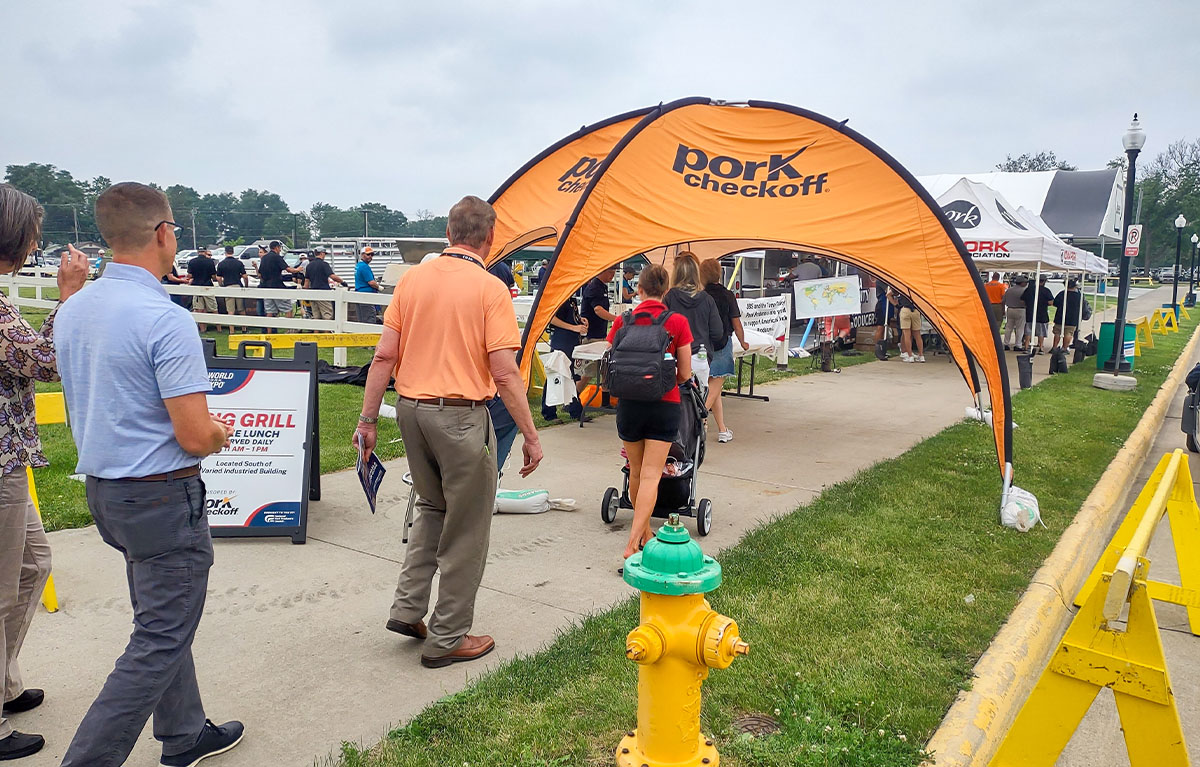
(Photo: Iowa Soybean Association/Jeff Hutton)
Pork industry evaluates potential disruptors
June 8, 2023
What will happen next for pork producers following the Supreme Court’s ruling on California’s Proposition 12 and how it will impact them and consumers?
That was the big issue raised during this week’s World Pork Expo as pork producers, vendors and visitors gathered at the Iowa State Fairgrounds in Des Moines.
“We’re going through some challenging times right now,” says National Pork Producers Council (NPPC) CEO Bryan Humphreys. “The Supreme Court ruling on Prop 12 will send shockwaves well beyond agriculture. Every American will be impacted by this decision.”
California woes
Prop 12 prohibits California to sell pork from hogs whose mothers (sows) were raised in pens – in Iowa and elsewhere – that do not comply with California’s “highly prescriptive” housing standards. The law applies to all uncooked pork sold in California, whether it was produced there or outside its borders. As written, the law means nearly all pork produced in the United States would fail to meet California’s standards.
Scott Hays, president of the NPPC, says the decision was devastating to the industry’s nearly 66,000 U.S. pork producers.
“When we got the ruling … it was a low point,” says the sixth-generation pork producer from Missouri. “Prop 12 is not good for pigs, it’s not good for producers and it’s not good for consumers … Forces outside of agriculture and continuing to raise our costs, raise costs on the products. It’s morally wrong to do that, especially issues like Prop 12. It’s hurting real people.”
Hays says NPPC and its producer-members remain focused on keeping products on the shelf in California and elsewhere.
“We’re trying to help them understand about implementing these changes,” he says, adding that officials in the Golden State thus far have not published rules about compliance, given that “everyone in the supply chain has had a difficult time understanding how to be compliant.”
Hays says he hopes Californians, as well as legislators, need to recognize the importance of protecting producers’ freedom to farm and freedom to operate.
“If producers have choices, consumers have choices,” he says.
“Producers are feeling a lot of pain. We’re going to continue to move product wherever we can, both domestically and overseas. We’ll work through this.”
Maria Zieba, NPPC’s vice president of international affairs, says the size of California’s impact on the pork industry cannot be understated, given that the state represents 15-16% of domestic pork consumption.
With the recent ruling, however, it could create greater opportunity for foreign competition to vie for California’s pork needs.
“It’s a great shame that you’re going to have foreign markets have better access to California (markets),” Zieba says. “If California voters knew the impact on the availability and sustainability, I think they would have voted a little differently.
Trade issues
Pork producers currently export close to 25% of their products to overseas markets, but additional markets would bolster pork producers’ prospects.
Zieba says expansion into places like southeast Asia, including Vietnam and other areas would be helpful, establishing free-trade and comprehensive agreements with those counties is imperative.
“We have such an opportunity there,” she says. “But right now, our tariffs are three times higher than our competitors. It’s very, very difficult for our exporters.”
Zieba says NPPC continues to work with the Biden administration and Congress to find solutions in lowering trade barriers with southeast Asia and other regions across the globe.
Foreign Animal Disease discussion
Maintaining – and expanding – trade opportunities can only continue if pigs remain healthy. That’s why the pork industry remains focused on keeping African Swine Fever (ASF) and other foreign animal diseases of the United States.
Dr. Anna Forseth, NPPC director of animal health, says harmonizing state and federal response to an outbreak, and more importantly emphasizing prevention and preparedness, is a focus for pork producers.
She says filling gaps in traceability and creating standardized movement permits are important considering how many animals are transported across state lines.
While the United States has been successful in making sure ASF has not impacted U.S. pork operations, vigilance is key.
“We’ve got to stay diligent; prevention is the key,” Hays says, adding that the NPPC is looking at every way the virus and other diseases could impact U.S. swine populations.
“We have got to get our arms around it quickly, because it would be so devastating,” he says. “It never leaves producers’ minds completely.”
Forseth says there are opportunities to improve the current traceability system from getting animals from the farm to the plant to the meat counter.
Zieba agrees and says NPPC continues to work with its trading partners on effectively preventing ASF and other foreign animal diseases from impacting markets.
“We have to continue the conversations with how we operate and on the systems we have in place,” she says. “We all need to work together. We’re in the commodity business. We have to figure out how to do it better and to do it cheaper every day without compromising quality or animal care. There are no bigger animal lovers than our producers.”
Final analysis
Despite the challenges, Humphreys says U.S. pork producers are the best at what they do.
“We market 140 million pigs annually, support more than 610,000 jobs, purchase 1.6 billion bushels of corn and export $7.6 billion worth of products to more than 100 foreign destinations,” he says. “We contribute $57 billion to the Gross Domestic Product, and we are the driving force of rural America.”
Back